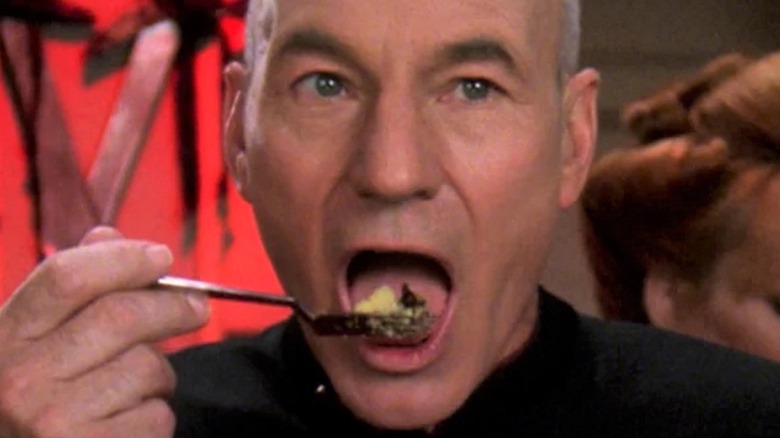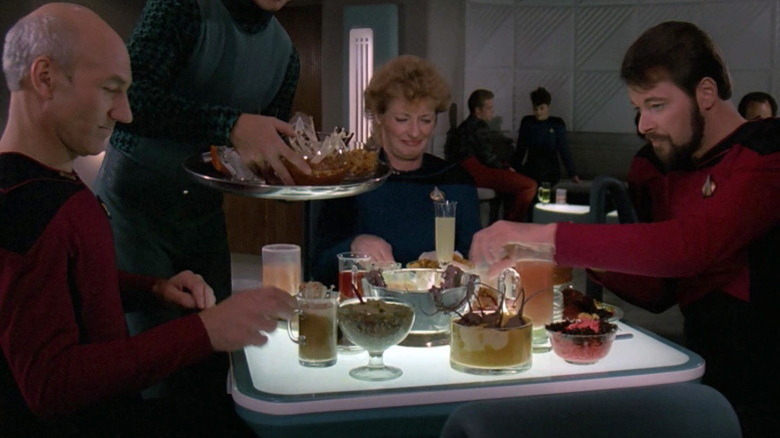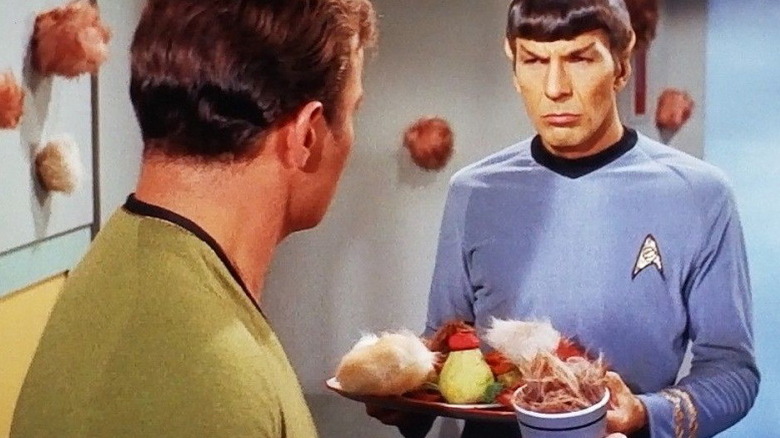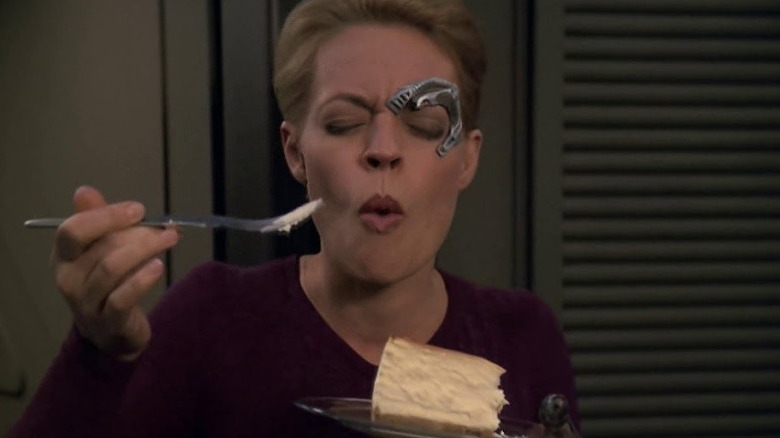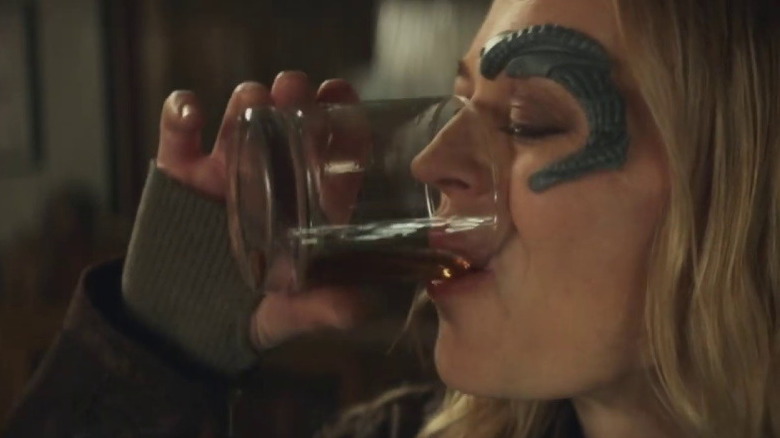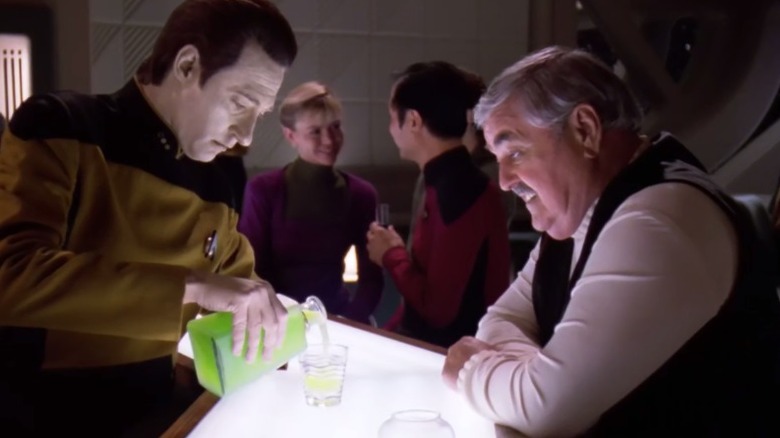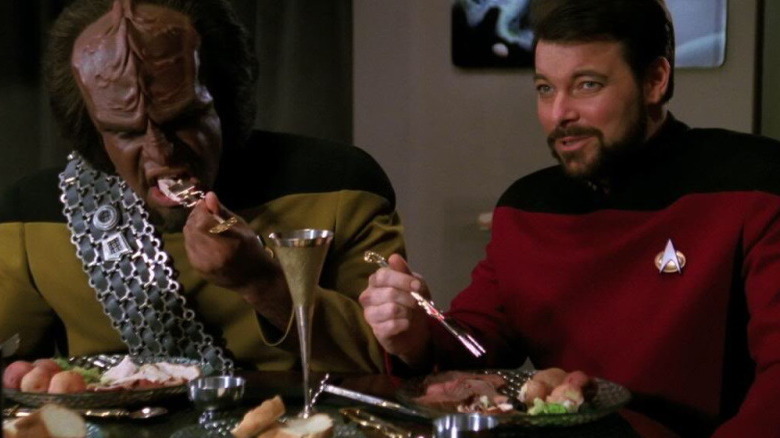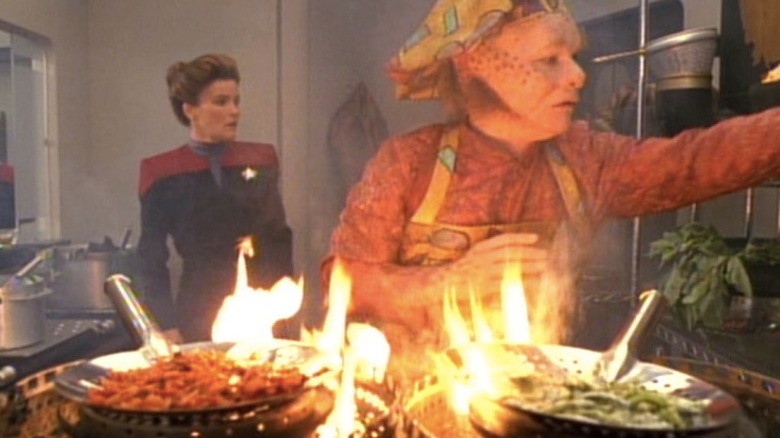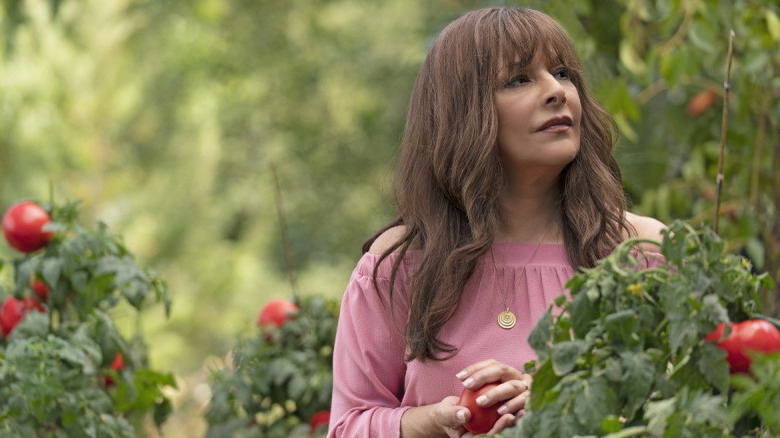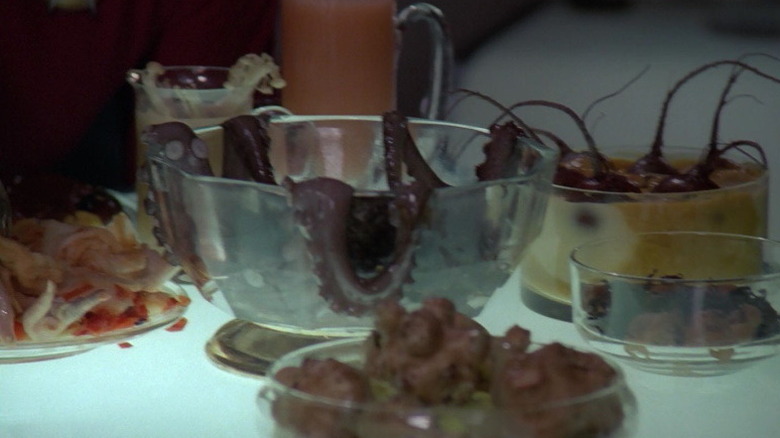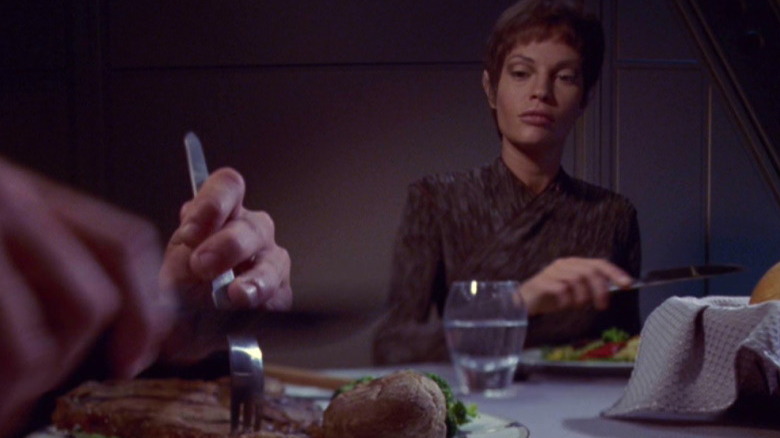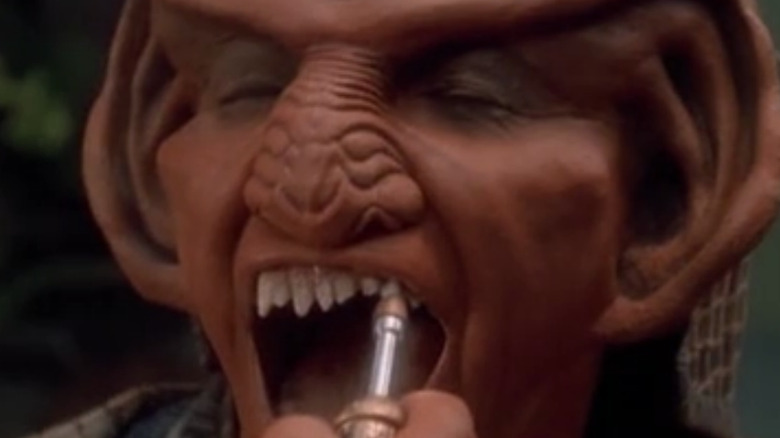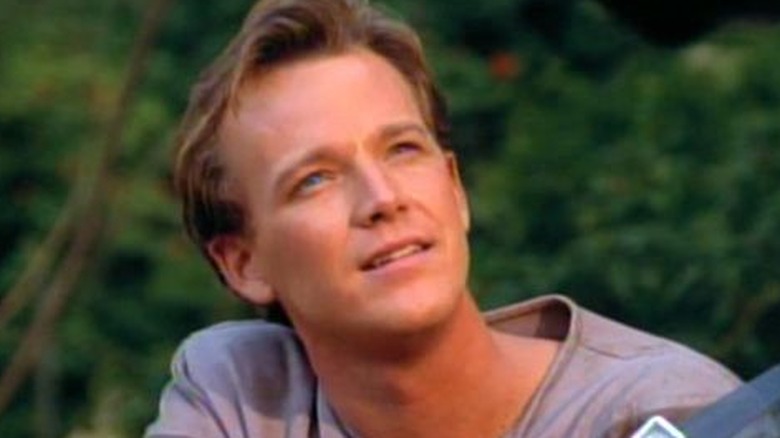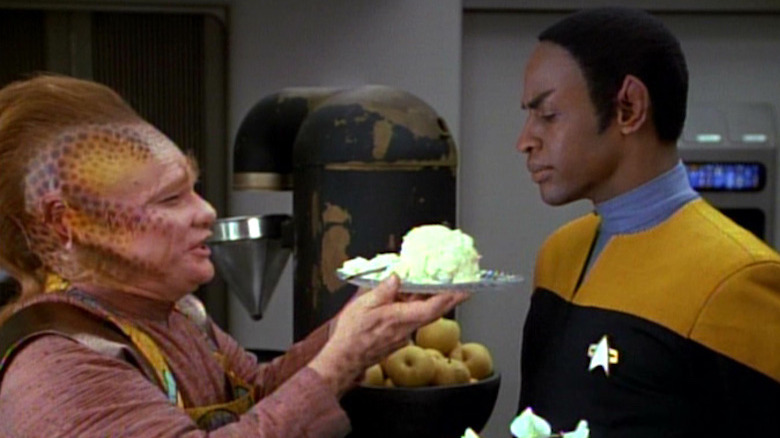Star Trek: What Eating On The Enterprise Would Really Be Like
"Star Trek" depicts a future where humanity has finally achieved a utopian society — one where different races, genders, and species all exist harmoniously together. And while some might claim Zefram Cochrane (James Cromwell), the inventor of the warp drive, ushered in this new age when his ship made contact with alien life and helped unite everyone on Earth, the truth is humanity owes a greater debt to a different piece of future technology — the food replicator.
Made popular on "Star Trek: The Next Generation" ("TNG"), food replicators are found on every starship and most Federation planets, and they can convert energy into virtually any type of food or drink. Thanks to this invention, food insecurity and starvation are truly problems of the past, and everyone who lives on Earth or serves aboard a ship like the U.S.S. Enterprise can go about their business with a full stomach — which plays a key part in maintaining the peaceful society humanity thrives in.
That said, there are a few downsides to living in a society where computers let you try cuisines from hundreds of different worlds. Due to replicator malfunctions or alien food allergies, dining aboard a starship can be an adventure in and of itself. But if you've ever wondered what sort of dishes you might try in the world of "Star Trek," read on. From getting drunk on Romulan ale to teasing your stomach with Klingon gagh, here's what eating on the Enterprise would really be like.
You can order anything you want on the Enterprise
Foodies who enjoy broadening their palates by sampling exotic dishes will feel like they're in paradise aboard the Enterprise. Not only does the ship's database contain a library of recipes from hundreds of different alien worlds, you can sample practically all of them thanks to the food replicators located in your quarters or in the ship's recreation lounge, Ten Forward.
The next generation model of the "food synthesizer" made popular in the original "Star Trek" series, the food replicators in "TNG" use the same matter-energy conversion technology used by transporters to transform molecules into anything you want — including a five-course meal. All you need to do is ask the computer for a bowl of Ratamba stew or a Bolian souffle, and the replicator will manifest it for you immediately using the ship's replicator reserves.
There are a few limitations — the Enterprise won't let you replicate anything poisonous or dangerous — but otherwise, you and your fellow gourmets could spend many happy hours hanging out in Ten Forward and indulging in Bajoran, Ktarian, or Betazoid cuisine. And best of all? Since money isn't used among Federation citizens, everything is free! Sure, it might get attacked by the Borg or thrown back in time every other week, but when it comes to food, the Enterprise is the ultimate cruise ship.
Doing the dishes is ridiculously easy
Automatic dishwashers may have revolutionized sanitation in the modern age, but people in "Star Trek" have an even better way of doing the dishes — just let the replicator dematerialize your used plates, uneaten food, and utensils. This eliminates the need to store drinking glasses or waste water, saving both space and resources. This also explains how a ship like the Enterprise always seems to have more than enough of everything. Thanks to the replicators' ability to recycle anything, spare molecules can be rearranged into any number of useful items like engineering equipment, medical supplies, or even clothes.
Of course, since food replicators are capable of creating anything from the ship's replicator reserves, that also means your next meal could be constructed out of atoms that used to be part of a champagne glass or a chafing dish. So, if your next replicated meatloaf tastes like it was made out of your old gym socks ... that's probably because it was.
Replicated junk food is good for you
Unsurprisingly, being able to order anything you want from a food replicator causes a lot of people to indulge, and many of the Enterprise's crewmembers like to replicate junk food. However, "junk food" in the 24th century isn't anywhere near as unhealthy as it is in our time.
By default, the Enterprise's replicators are designed to manifest food and drink with nutritional value. So when Counselor Troi (Marina Sirtis) orders chocolate ice cream or caviar from the replicators, she's actually eating healthy. At one point in the "TNG" Season 3 episode "The Price," Troi says she can tell the difference between real and replicated ice cream when she asks for a chocolate sundae with real whipped cream. In response, the computer indicates it's programmed to provide foods of acceptable nutritional value and Troi would have to override its program to manifest actual junk food.
Oddly enough, this means that if the alien trickster Q (John de Lancie) had eaten the 10 replicated chocolate sundaes he ordered shortly after becoming human in the Season 3 episode "Deja Q," he might've ended up with better muscle tone and stronger bones. One can only dream that future miracle diets will include such replicator rations.
Bar-hopping won't get you drunk
Guinan (Whoopi Goldberg) may be the Enterprise's bartender, but the truth is most of the beverages served at Ten Forward are non-alcoholic. By the 24th century, synthehol is the drink of choice for many Starfleet officers. According to Data (Brent Spiner) in the "TNG" Season 6 episode "Relics," synthehol is an alcohol substitute that "simulates the appearance, taste, and smell of alcohol." However, the intoxicating effects of synthehol drinks are easily ignored.
On one hand, this makes sense. Starfleet doesn't want their officers to show up at their duty stations hungover, so synthehol appears to be an acceptable compromise for bar-hoppers. However, this revelation horrifies Montgomery Scott (James Doohan), who knows immediately that the "scotch" he's served at Ten Forward is definitely not scotch.
Amusingly, it's later revealed in the "Star Trek: Voyager" Season 5 episode "Timeless" that the one alien species that can get hammered from synthehol is ... the Borg. That's right, Starfleet's most dangerous enemy is incapable of holding their liquor, as seen when Seven of Nine (Jeri Ryan) gets drunk from just one glass of non-alcoholic champagne. A few years later, however, Seven shows the Borg nanoprobes in her blood apparently adapted to her low tolerance when she chugs back multiple shots of real bourbon in "Star Trek: Picard." That, or she's become a full-blown alcoholic.
There are plenty of ways to get wasted on the Enterprise
"Star Trek" may depict a future where humanity has risen above the bad habits of its ancestors, but apparently, humans still haven't conquered their self-destructive tendency to get completely plastered. Although synthehol may keep most crewmen sober, there are still plenty of alcoholic beverages on the Enterprise that are far more intoxicating than anything you can encounter in the 21st century.
Shortly after Scotty shows his displeasure at being served synthehol drinks in "Relics," Data reveals that Guinan keeps a limited supply of real alcoholic beverages and serves him from a very potent bottle of "Aldebaran whiskey." Other episodes reveal aliens consuming kanar, a thick Cardassian liquor, as well as Romulan ale, a blue drink that's so intoxicating it's been made illegal by Starfleet. Despite this, practically everyone from Kirk to Riker has smuggled in and shared Romulan ale at parties and even state dinners, showing that Starfleet officers aren't just explorers — they're bootleggers.
Okay, but surely Captain Picard (Patrick Stewart) wouldn't approve of all this alcohol floating around his ship, right? Not quite. Turns out, he's the one who gave Guinan the bottle of Aldebaran whiskey that Scotty enjoyed, and he's more than capable of holding his liquor alongside Mr. Scott. Considering that Picard's family has owned a French vineyard for several centuries, it's not surprising that the captain has an appreciation for fine wine and alcoholic beverages.
Cooking is a lost art
Technology does tend to strip a society of some basic skills, and in the case of food replicators, that skill happens to be cooking. When all you need to do to make lunch is ask your replicator for a hamburger and fries, learning how to chop your own meat or use a stove seems unnecessary. This has led many people to learn how to "cook" by programming replication patterns — essentially replacing cooking skills with coding skills.
Which can lead to some big problems. After all, replicators can get damaged, leaving you unable to synthesize your dinner or midnight snack. A few people, like Dr. Bruce Maddox (John Ales), dabble in cooking by trying to make chocolate chip cookies the old-fashioned way in the "Picard" Season 1 episode "Stardust City Rag." However, he still has to use the food replicator to create the flour, butter, eggs, sugar, baking soda, and chocolate chips to prepare the cookies, making his girlfriend, Dr. Jurati (Alison Pill), question the logic behind his actions.
Those who can cook are very passionate
Luckily, human society in the 24th century emphasizes finding personal fulfillment by honing skills, and some people are still very passionate about cooking. In the prequel series "Star Trek: Enterprise," the crew applauded the culinary skills of their cook, Chef. In the final episode, Chef was played by Commander William Riker (Jonathan Frakes) in a holodeck simulation. Riker, who loves cooking, once invited his crew mates for an Owon omelette in the Season 2 episode "Time Squared." However, most of the crew hated his meal — except Worf (Michael Dorn), who described it as "delicious."
Riker's cooking skills improve by "Picard," when he makes a pizza from scratch for his family and some unexpected dinner guests. And while we're off the Enterprise, let's head over to "Star Trek: Deep Space Nine," where Captain Sisko (Avery Brooks) also enjoys cooking and learned his skills from his father, Joseph Sisko (Brock Peters), the master chef of a popular restaurant in New Orleans.
However, the most enthusiastic (and essential) cook in "Star Trek” is Neelix (Ethan Phillips), the Talaxian chef/morale officer in "Voyager." Since Voyager is stranded in the Delta Quadrant, replicator rations need to be limited, making Neelix responsible for most of the crew's meals. Although his early attempts do create several cases of food poisoning, some of his later attempts are more edible, and he proves very creative with the various ingredients the crew harvest from other planets.
People still raise their own food in the future
Replicators may be able to make food out of "simulated protein molecules," but most people agree that naturally grown food still produces the tastiest dishes. The Enterprise NX-01 has a hydroponic greenhouse where they grow fruits and vegetables for their meals, and the Enterprise-D has a hydroponic laboratory that can presumably do the same thing.
Many of the strange new worlds that Starfleet visits are also veritable Gardens of Eden. "Picard" finds William Riker living on the alien planet Nepenthe, where the soil has regenerative properties, allowing the Riker family to grow very rich tomatoes, basil, and other vegetables. After sampling a tomato, the android Soji Asha (Isa Briones) can immediately taste how "real" naturally grown food is compared to replicated meals.
But the one starship that truly got to appreciate home-grown food was the Voyager. After being stranded in the Delta Quadrant, the crew had to ration their supplies, which meant harvesting plants and other foods from alien planets and cooking them aboard their ship. One of the more unusual dishes was seen in the "Voyager" Season 2 episode "Parturition" when Lieutenant Tom Paris (Robert Duncan McNeill) eats some Alfarian hair pasta. Turns out, this pasta is made from the actual hair follicles of mature Alfarian animals that shed them every year in early fall.
Klingon cuisine is very strong
Klingons constantly like to prove how tough they are — including at the dinner table, where most of the dishes look like they were created on a dare. William Riker got to sample several types of Klingon food during a cultural exchange in the "TNG” Season 2 episode "A Matter of Honor." While he claimed to enjoy the bregit lung and rokeg blood pie, even he got squeamish when he was offered a dish of gagh – aka live serpent worms. A Klingon delicacy, there are at least 51 types of gagh, including varieties that squirm, jump, or wiggle as they make their way into your stomach.
Surprisingly, many "Star Trek" fans really want to try Klingon food, leading to the creation of several Klingon cooking blogs that instruct you on how to cook broiled krada legs (actually spider crab legs and Moreton Bay bugs), as well as multiple varieties of gagh (including one made of Japanese soba noodles).
And while genuine Klingon food may prove too strong for some palates, most people love Klingon beverages. Klingon bloodwine was frequently consumed on "Deep Space Nine," and many Starfleet officers found themselves hooked on raktajino, the Klingon version of coffee that could be served hot, iced, or with whipped cream. The drink was so popular, one wonders why some enterprising Klingon baristas didn't open up a whole chain of raktajino houses and become the 24th-century version of Starbucks.
Vulcan dishes tend to be bland
Where warrior races like the Klingons may prefer to eat meals rich in meat, the logical Vulcan race favors a more ... dispassionate cuisine. Many Vulcans, including the Enterprise's Mr. Spock (Leonard Nimoy) are vegetarians who prefer eating Vulcan fruits like gespar or various types of broth. Vulcans also don't like touching their food with their bare hands, making even a vegan barbeque out of the question.
In terms of popular dishes, Nurse Christine Chapel (Majel Barrett) once made a bowl of plomeek soup for Spock in the "Star Trek" Season 2 episode "Amok Time." Considered a traditional morning meal on Vulcan, plomeek soup is usually a bland broth (although there are spicier versions). Unfortunately, Spock was suffering from the Vulcan pon farr mating drive at the time and angrily threw the soup back at Nurse Chapel. He later apologized and requested that she make him another bowl.
Strangely, in the "Deep Space Nine" Season 2 episode "Melora," the Ferengi bartender Quark (Armin Shimerman) serves a dish of "jumbo Vulcan mollusks" to a diner. Since mollusks are meat, this has led to some speculation among fans over how strict the Vulcan vegetarian diet really is. Of course, if the mollusks were replicated, this could serve as a loophole for any Vulcans who chose to partake in such a meal.
Ferengi meal preparation is an ... intimate affair
There are some meals that even replicators can't fully prepare. Take Ferengi cuisine, for example. While a replicator may be able to produce a fair facsimile of beetle puree, slug liver, or Slug-o-Cola, within Ferengi culture, Ferengi women are required to cut up the meals and chew it to make it softer for the male members of the household. Some females, notably Quark's mother, Ishka (played by both Cecily Adams and Andrea Martin), refused to do this, leading other boys to ridicule Quark and his brother, Rom (Max Grodénchik).
Quark himself ran a popular recreational facility known as "Quark's Bar, Grill, Gaming House, and Holosuite Arcade" (or just "Quark's") on Deep Space Nine and served many alien foods and drinks. Most of his offerings were replicated, but he did have certain fresh wines and delicacies shipped in and indicated some of his meals were made from scratch.
Despite displaying traditional Ferengi greed, Quark was an excellent host, leading many "Star Trek" fans to want to go to Quark's — which they got to do at the Star Trek-themed attraction "Star Trek: The Experience" at the Las Vegas Hilton Hotel from 1998 to 2008. The real-life bar served several Ferengi dishes, including "Moogie's Famous Ferengi Flat Bread" and "Moogie's Choice Pasta."
Future food allergies can be ... weird
The 24th century has done a lot for medical science. In "TNG," Wesley Crusher (Wil Wheaton) states that the common cold has finally been cured. Human life spans have been vastly extended, and many illnesses can be immediately alleviated with just a single hypospray injection.
That being said, in a universe where people visit alien worlds every week, the chances of discovering a new food allergy are pretty high. Luckily, many of these allergies tend to be more weird than deadly. In the "Deep Space Nine” Season 5 episode "Let He Who Is Without Sin ..." Lieutenant Jadzia Dax (Terry Farrell) admits she's allergic to icoberry juice (it makes her spots itch), but she likes it so much that she drinks it anyway. Other episodes show that the entire Talarian species can become intoxicated by Klingon raktajino.
On "Voyager," some people react so violently to Neelix's cooking that the Doctor (Robert Picardo) once compared Neelix's Bolian souffle to a bio-weapon in Season 7's "Body and Soul." Tom Paris once had a severe allergic reaction to the water in Neelix's coffee in Season 2's "Threshold" (although to be fair, Paris' body was already mutating into a salamander after he broke the transwarp barrier and was developing new allergies).
Even starships can have food allergies
With all the different alien species aboard Federation starships, it was perhaps inevitable that many people would have unique food allergies — but that's nothing compared to the time a starship developed a food allergy.
In the "Voyager" episode "Learning Curve," one crewmember requests that Neelix make some macaroni and cheese, leading the Talaxian to culture some brill cheese from the schplict milk he acquired from an alien grakel. Unfortunately, the bacterial spores inside the cheese contain an alien virus that infect the bio-neural gel packs on Voyager. This causes every system aboard Voyager to become "sick," and the holographic Doctor is forced to kill the virus by raising the temperature aboard the entire ship, causing multiple crewmembers to pass out from heat stroke.
So, while making meals may have gotten simpler in the future, major dinner party disasters are still very much a thing.
